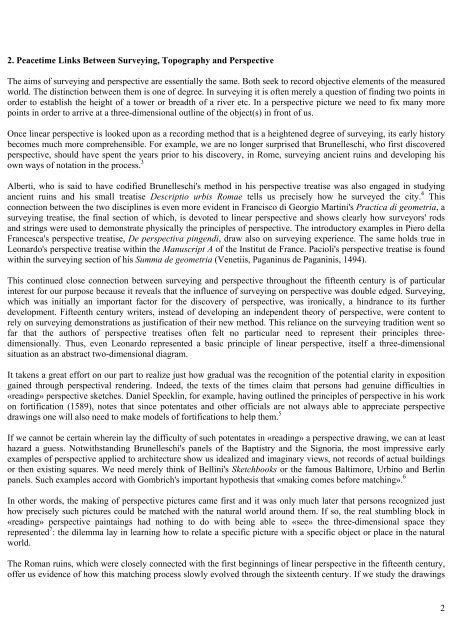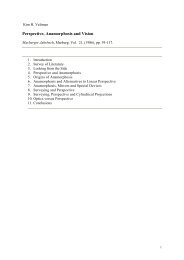1 Kim H. Veltman Military Surveying and Topography: The Practical ...
1 Kim H. Veltman Military Surveying and Topography: The Practical ...
1 Kim H. Veltman Military Surveying and Topography: The Practical ...
You also want an ePaper? Increase the reach of your titles
YUMPU automatically turns print PDFs into web optimized ePapers that Google loves.
2. Peacetime Links Between <strong>Surveying</strong>, <strong>Topography</strong> <strong>and</strong> Perspective<br />
<strong>The</strong> aims of surveying <strong>and</strong> perspective are essentially the same. Both seek to record objective elements of the measured<br />
world. <strong>The</strong> distinction between them is one of degree. In surveying it is often merely a question of finding two points in<br />
order to establish the height of a tower or breadth of a river etc. In a perspective picture we need to fix many more<br />
points in order to arrive at a three-dimensional outline of the object(s) in front of us.<br />
Once linear perspective is looked upon as a recording method that is a heightened degree of surveying, its early history<br />
becomes much more comprehensible. For example, we are no longer surprised that Brunelleschi, who first discovered<br />
perspective, should have spent the years prior to his discovery, in Rome, surveying ancient ruins <strong>and</strong> developing his<br />
own ways of notation in the process. 3<br />
Alberti, who is said to have codified Brunelleschi's method in his perspective treatise was also engaged in studying<br />
ancient ruins <strong>and</strong> his small treatise Descriptio urbis Romae tells us precisely how he surveyed the city. 4 This<br />
connection between the two disciplines is even more evident in Francisco di Georgio Martini's Practica di geometria, a<br />
surveying treatise, the final section of which, is devoted to linear perspective <strong>and</strong> shows clearly how surveyors' rods<br />
<strong>and</strong> strings were used to demonstrate physically the principles of perspective. <strong>The</strong> introductory examples in Piero della<br />
Francesca's perspective treatise, De perspectiva pingendi, draw also on surveying experience. <strong>The</strong> same holds true in<br />
Leonardo's perspective treatise within the Manuscript A of the Institut de France. Pacioli's perspective treatise is found<br />
within the surveying section of his Summa de geometria (Venetiis, Paganinus de Paganinis, 1494).<br />
This continued close connection between surveying <strong>and</strong> perspective throughout the fifteenth century is of particular<br />
interest for our purpose because it reveals that the influence of surveying on perspective was double edged. <strong>Surveying</strong>,<br />
which was initially an important factor for the discovery of perspective, was ironically, a hindrance to its further<br />
development. Fifteenth century writers, instead of developing an independent theory of perspective, were content to<br />
rely on surveying demonstrations as justification of their new method. This reliance on the surveying tradition went so<br />
far that the authors of perspective treatises often felt no particular need to represent their principles threedimensionally.<br />
Thus, even Leonardo represented a basic principle of linear perspective, itself a three-dimensional<br />
situation as an abstract two-dimensional diagram.<br />
It takens a great effort on our part to realize just how gradual was the recognition of the potential clarity in exposition<br />
gained through perspectival rendering. Indeed, the texts of the times claim that persons had genuine difficulties in<br />
«reading» perspective sketches. Daniel Specklin, for example, having outlined the principles of perspective in his work<br />
on fortification (1589), notes that since potentates <strong>and</strong> other officials are not always able to appreciate perspective<br />
drawings one will also need to make models of fortifications to help them. 5<br />
If we cannot be certain wherein lay the difficulty of such potentates in «reading» a perspective drawing, we can at least<br />
hazard a guess. Notwithst<strong>and</strong>ing Brunelleschi's panels of the Baptistry <strong>and</strong> the Signoria, the most impressive early<br />
examples of perspective applied to architecture show us idealized <strong>and</strong> imaginary views, not records of actual buildings<br />
or then existing squares. We need merely think of Bellini's Sketchbooks or the famous Baltimore, Urbino <strong>and</strong> Berlin<br />
panels. Such examples accord with Gombrich's important hypothesis that «making comes before matching». 6<br />
In other words, the making of perspective pictures came first <strong>and</strong> it was only much later that persons recognized just<br />
how precisely such pictures could be matched with the natural world around them. If so, the real stumbling block in<br />
«reading» perspective paintaings had nothing to do with being able to «see» the three-dimensional space they<br />
represented 7 : the dilemma lay in learning how to relate a specific picture with a specific object or place in the natural<br />
world.<br />
<strong>The</strong> Roman ruins, which were closely connected with the first beginnings of linear perspective in the fifteenth century,<br />
offer us evidence of how this matching process slowly evolved through the sixteenth century. If we study the drawings<br />
2



